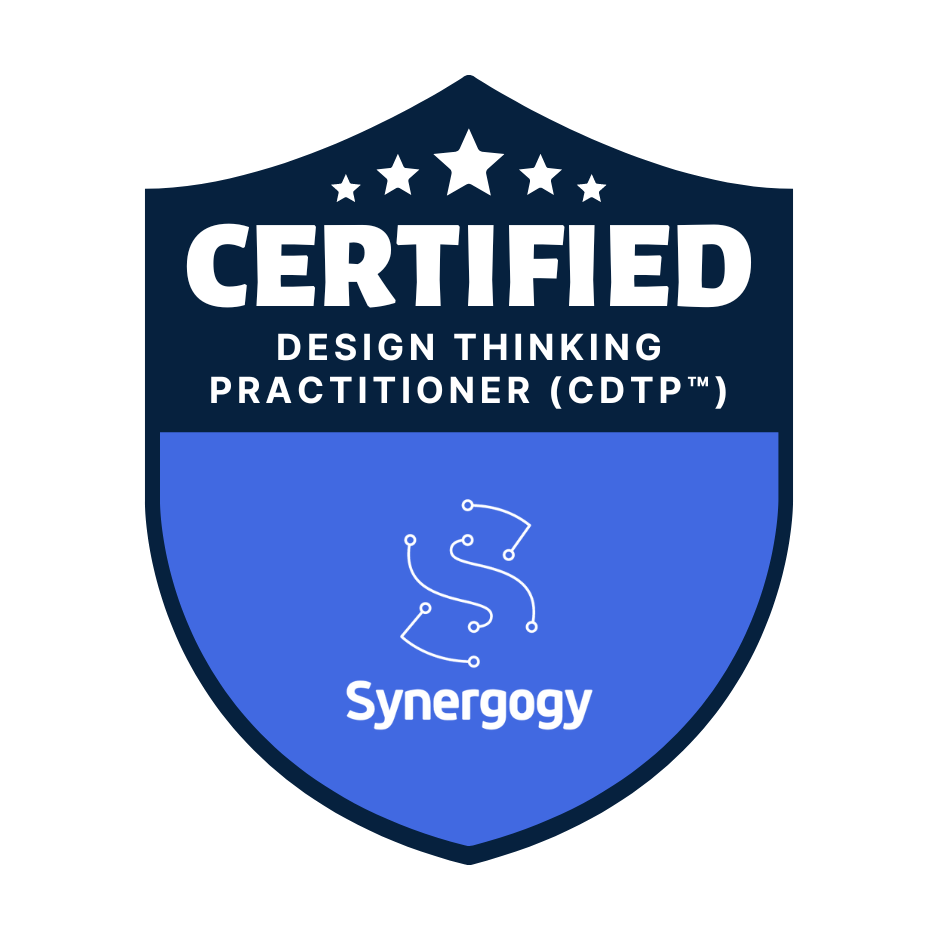India’s Premier Design Thinking Certification Program – CDTP™

In a world consistently propelled by digital innovation, the realm of Design Thinking is becoming increasingly prominent. The torchbearer in this transformative journey, particularly in India, is the Synergogy Design Thinking Certification program. More than just an educational platform, Synergogy offers an unrivalled roadmap to a prosperous and burgeoning professional future.
Synergogy’s Design Thinking Certification Program: Embracing Innovation
Synergogy’s program effortlessly integrates theoretical knowledge and practical application, immersing you in the stimulating world of Design Thinking. Being India’s top-notch program, it arms you with indispensable skills required to ideate, invent, and devise innovative solutions. With the key areas of focus ranging from understanding user empathy to problem identification, ideation, prototype development, and testing, a comprehensive understanding of the Design Thinking spectrum is ensured.
One unique feature of the Synergogy course is the Certified Design Thinking Practitioner (CDTP)™ certification, endorsed by the Human Resource Certification Institute (HRCI). This stamp of approval, worth 16 credits, gives you an edge in the professional world. Synergogy’s certification not only stands as proof of your learnings but significantly boosts your professional credentials.
Reinventing the Innovation Curve with Synergogy
In the realm of innovation, the concept of constantly reshaping your S-Curve is critical. Whether you’re a budding entrepreneur, an established manager, an academician, or working in government, staying relevant is paramount. Synergogy’s Design Thinking program fosters ‘leapfrog’ ideas that alter the game and offers the advantage of being a pioneer in your field.
When designing a new product, service, or crafting a fresh go-to-market strategy, challenging your thought process is vital. Leveraging design thinking principles, models, and skills can help to shift your mindset, leading teams towards continuous innovation. It enables the creation of products or services that provide value to your organization and its customers.
Immerse, Innovate, Impact: The Synergogy Learning Experience
The Synergogy methodology integrates synergistic adult learning principles. This approach provides a plethora of hands-on, immersive blended learning opportunities through an array of resources. You will engage in action learning exercises, delve into case studies, and take part in Capstone projects that will allow you to put theory into practice. This comprehensive learning experience equips you with the essential skills to conquer the professional world.
The course materials provided to participants are meticulously curated, including a participant workbook, Design Thinking templates, skills cards, and process checklists. All these resources aim to guide you through your learning journey smoothly and efficiently.
Synergogy’s Design Thinking Certification: A Multitude of Benefits
The certification by Synergogy presents numerous benefits, including professional accreditation and a digitally authenticated badge, valid for a lifetime without the need for renewals. Not to mention, the action learning experiences throughout the course enhance your understanding and ability to apply Design Thinking principles in practical scenarios.
Moreover, Synergogy’s course provides flexibility with its range of customizations. The CDTP™ course can be tailored to suit your specific industry or business unit context. It can be delivered face-to-face or virtually, and the duration can be adjusted to fit your needs.
Synergogy’s Experience: Bridging the Design Thinking Universe
Synergogy has been a trailblazer in Design Thinking for over a decade, with a commitment to a synergistic andragogy approach to learning. Their Design Thinking Certification course reflects years of experience working in design labs and with clients from various industry sectors worldwide.
This course equips you with tried & tested design thinking models, principles, and skills. It addresses business challenges and assists in building products, services, and strategies that yield fruitful results. With cohort-based learning, a wealth of practice, and industry examples, this course is geared to turn you into a Design Thinking expert.
Final Thoughts
Whether you are new to the universe of Design Thinking or seeking to enrich your existing knowledge, Synergogy’s Design Thinking Certification Program serves as an ideal stepping stone. This journey will not only enhance your professional network but also prepare you for a successful professional future.
Contact Synergogy today and explore the fascinating world of Design Thinking. This could be your chance to learn, grow, and lead in your industry with confidence and innovative prowess.
Become an Expert in Design Thinking with Synergogy’s Certified Design Thinking Practitioner – CDTP™
Become a Design Thinking expert! The CDTP™ Design Thinking Certification course is endorsed by HRCI – Human Resource Certification Institute (HRCI) for 16 credits.
Constantly re-inventing your S-Curve is the key to innovation. Whether you are a start-up entrepreneur or a manager, whether you are an academician or in government – staying relevant is the key to survival. Design Thinking can help you create those ‘leapfrog’ ideas that change the game and get you the first movers advantage.
Certified Design Thinking Practitioner – CDTP™
Breakthrough innovation happens at the intersection of user centricity, commercial viability, and technological feasibility. Design thinking integrates all three and delivers business value. Here are some important statistics that shed light on the criticality of Design Thinking for businesses today.
Choose from a range of solutions to suit your every need. Our Certified Design Thinking Practitioner CDTP™ course can be customised to your industry or business unit context. What’s more, we are happy to deliver this course face to face or in virtual, instructor-led formats.
This course provides you with all the necessary tools and skills to create a mindset change, adapt behaviors and learn new ways to tackle problems at work. With cohort based learning, plenty of practice and examples from various industries, this course will equip you to become an expert in Design Thinking. To build your Design Thinking muscle, you even get to work on a capstone project within your organisation.

- Endorsed by HRCI
- Digital Badge
- Professional Certification
- Online or Face-to-face formats